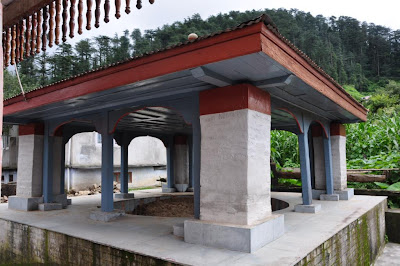Seeing the temples of Dhanu Devta come close to what Edna St. Vincent Millay says... "A lovely temple, tenantless, Long since that was once sweet with shivering brass".
The name Dhanu Devta (धानु देवता) comes from the word "dhaan" for rice-grain. Shri Sevak Ram ji, who is one of the "kaardars" (protector, retainer) of the temples recounts an interesting tale. There was once a man who would take his herd out to graze to a particular spot every day. One evening, he found that his cow would not give her usual quantities of milk. So he set out to discover why. Many days later, he espied a strange sight. Every evening, a snake would appear out of nowhere, wind itself around the cow's legs and drink milk straight from its udders. The man, frightened, fell to his feet. He begged the snake to reveal its true identity. The snake revealed himself as Dhaanu Devta and said he had come to rest hear after having tried several other villages and places. In gratitude, the village built him a fine temple near a flowing stream.
In time, the villagers of Vihar, or Bihar, and the hamlets of Klel, built two other temples for the deity and his younger sibling to visit.
The three temples are built at three different elevations, within a radius of a kilometre.
The one you see below is temple no. 1. The architecture of Himachali temples is unlike anything you'd see anywhere in India. For one thing, observe the geometry. There is a small platform. On this is built the sanctum sanctorum which no one except the retainers (all men) can enter. This is surmounted by a structure wider than the one below, which is then topped off by a double sloping, almost pagoda-like roof.
 An interesting detail. Men, it seems, are as attached to the accesories of a cult as they are to their deity!
An interesting detail. Men, it seems, are as attached to the accesories of a cult as they are to their deity!
A representation of the deity on the door (locked, you'll notice) to the sanctum sanctorum. It is interesting that the deity who guards the door is a mutli-armed female riding what looks like a tiger!


---
Walk further down a winding path through fields of maze. Around the corner is temple no. 2. Of all three, this one looks the most distressed. Almost an example of the less preferential treatment that younger siblings often allege they are given! Shri Sevak Ram announces that this is the shrine of the "younger brother".



-----




As Voltaire says:
Sacred to peace, within a wood's recess,
A blest retreat, where courtiers never press,
A temple stands, where Art did never try
With pompous wonders, to enchant the eye,
There no dazzling ornamets, nor vain,
But truth, simplicity and Nature reign...
The path which ran down the hill from Kanlog is almost completely overgrown and therefore, hidden from view. This may make tracking the path to the main, the lowest temple a tough task. A better way of approaching the holy triad is by way of Khalini. When you approach Khalini from the the town, ask for the turnoff for Bihar-gaon. You have to follow the nearly kilometre-long path to this hamlet. There's no simple way to describe this path except to state that the road is metalled for about half the distance. The good thing is that there are no forks on the way, so, asking nicely, you will be able to eventually find your way down to the temples.
I strongly suggest that you ask first for Bihar-gaon and then for Shri Sevak Ram Sharma. This is far likely to fetch you the desired result of seeing the temples, than the asking for directions to the shrines directly. It is also not advisable to try and locate the temples by yourself, because tiny as the span of the location is, none of the temples are visible from the upper Bihar-gaon road, or indeed, from the village pathways. While trying to discover the shrines would be entertaining, it might eventually tire, or even bore the less stout of heart (or foot!).
I can assure you, however, that once you do chance upon these hidden gems, you won't regret the trek you've had to make!
Caveat: the distance to Bihar-gaon is best covered by a vehicle so that you can conserve your energy for the little hike below. In my rough estimation, the distance is about three kilometres from the road-head at Khalina, but all of it goes uphill and downhill and winding this way and that.
For more specific directions, leave a message here and I'll get back to you.
I shall save the tale of the accidental discovery of the Zoroastrian Cemetery for another day!





5 comments:
Great post! It looks beautiful.
It amazing that 'cow, milk and temple' is so often cited in the 'Origin Story' for some Shiv temples of North India. People tell a similar tale for Amarnath. Interesting.
Gosh, yes, Vinayak, so they do! This trio of temples is incredible - as is the path that leads up to it and the temple's retainer has to be one of the warmest & most generous person ever.
How very unusual - fascinating.
Yes, Ann... You won't get to see architecture of this sort anywhere else in India.
Fascinating story and temples.
Post a Comment